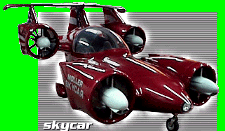

TechnoFILE is copyright and a registered trademark © ® of
Pandemonium Productions.
All rights reserved.
E-mail us Here!

Fancy Flights in your Automotive Future?By Jim Bray Freeway congestion may become a thing of the past if some new personal transportation concepts manage to get off the ground. Flying cars are an old concept, but they’re seeing new life thanks to a handful of upward-looking companies. The first is Moller International of Davis, California, whose M400 Skycar appears well on the way to bringing mainstream society an honest to goodness family flying machine like that used by George Jetson on the old cartoon show. The Skycar volantor (from the Italian “Volant,” literally meaning “flying”) is a VTOL (vertical takeoff and landing – like a helicopter or a Harrier jet) vehicle that’s about the size of a car. According to Moller’s hype, the four seat vehicle will cruise at more than 350 mph, get a fuel economy of 15 mpg, and retail (eventually) for about $60,000. Paul Moller has already flown a two passenger prototype so, while the future of this vehicle is still up in the air, the idea seems infinitely more down to earth than pie in the sky. Puns notwithstanding, the volantor and its competitors use the directional application of jets of air, in the Moller’s case air thrust from four “nacelles” in which the engines are mounted. Moller claims the M400 will be able to climb, at up to 7800 feet per minute, to a maximum ceiling of 30,000 feet. They also say it’ll have a range of 900 miles and will carry a payload of up to 740 pounds, including its (regular automobile) gas. It’ll only require an area of about 35 feet in diameter to take off or land, too. For comparison, Cessna’s Web site says the base model of its classic four seat 172 Skyhawk – the little airplane that’s one the backbones of personal aviation – climbs at 720 feet per minute, with a ceiling of 13,500 feet and a cruising speed of about 140 mph. It also requires about a thousand feet of runway, starts at $144,900 and, though flying isn’t really difficult, requires an expensive pilot school course and many hours of experience before you’re comfortably proficient. The M400 will be 18 feet long, 9 wide, and 6 high which, compared to a current Honda Accord’s dimensions of about 15.8 x 5.9 x 4.8, means it should fit quite well into your driveway. It’s also capable of moving short distances on the ground, so it should be parkable. Moller says that the volantor will be flown by computers using Global Positioning Satellites (GPS), which will eventually make it accessible to non pilots. Until the concept is proven, however, operators will need a private pilot’s license, though this is supposedly only a temporary hurdle. Power is provided by Wankel-type rotary engines, known for their small size, light weight, and reliability. The power plants have only three major moving parts and weigh less than 80 pounds each. The M400 will carry eight of these 150 horsepower motors, two per engine nacelle, running independently of each other to help prevent the skycar from experiencing an embarrassing plummet should one fail. The computer stabilization systems are tripled, for the same reason, with only one required to fly the M400. If all else fails, dual parachutes can be deployed that are designed to waft the M400 gently to the ground. The company’s also planning six passenger and single passenger versions of the volantor. Moller isn’t alone in telling humanity to take a flying leap, though they do seem to be the farthest along in development and, perhaps, the most feasibly mainstream. Other companies working on the concept include Macro Industries, of Huntsville Alabama, which is developing the 2 passenger SkyRider X2R. Then there’s the Israeli company AD&D, whose CityHawk is also a 2 seat concept. Huntington Beach, California’s Advanced Flying Automobile is hard at work on the SOKOL A400, a car that can supposedly convert into a plane, complete with pop out wings, in less than a minute. Once the technology has been worked out the problem will be managing the traffic. After all, while the idea of airborne commuter traffic is wonderful, the last thing the world needs is skycars raining down on homes and pedestrians as lousy drivers take to the air. Hopefully, sky car drivers will be required to have a little more skill than many drivers of ground-based vehicles currently display… Jim Bray is a member of the Automobile Journalists Association of Canada. His columns are available through the TechnoFile Syndicate. |
Support TechnoFile via Paypal |
TechnoFILE's
E-letter We're pleased to offer our FREE private, subscription-based private E-mail service. It's the "no brainer" way to keep informed. Our Privacy Policy |